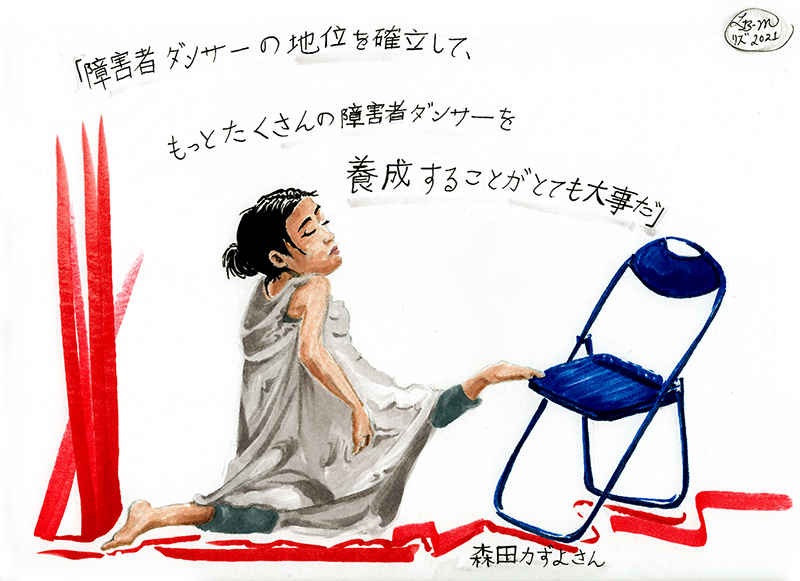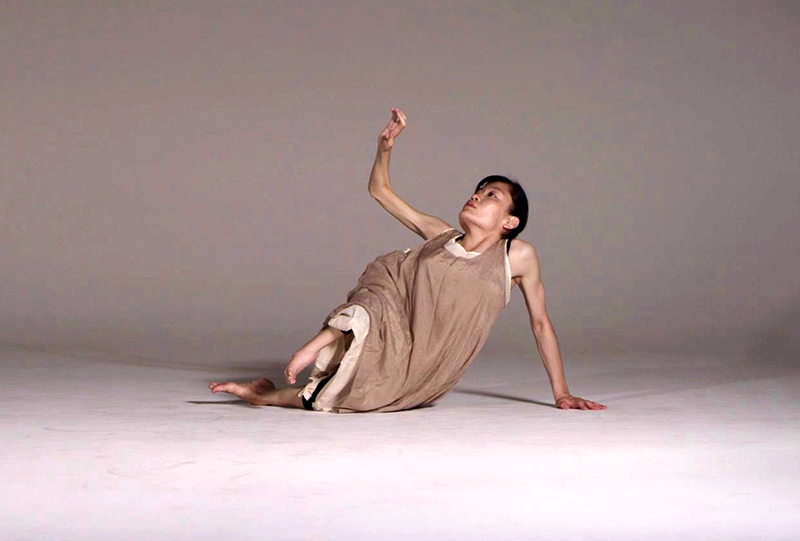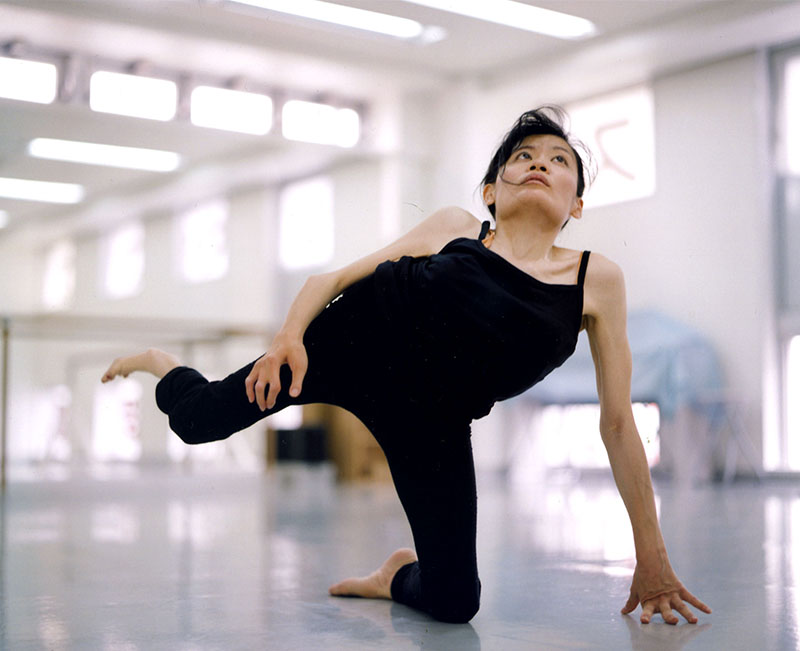Kazuyo Morita: “We Need Role Models”
BY SILVA LAUKKANEN; TRANSLATED BY YUKA MATSUDAIRA; EDITED BY EMMALY WIEDERHOLT; ILLUSTRATION BY LIZ BRENT-MALDONADO
Kazuyo Morita is a dancer and actress from Osaka, Japan. As the leader/founder of “Performance for All People – CONVEY,” Kazuyo has performed in such events as the Yokohama Paratriennale and Happy Spot Nara, as well as collaborated with SLOW MOVEMENT, Knit Cap Theater, and Niwa Gekidan Penino. Kazuyo also teaches workshops, choreographs, and directs dance performances for people with disabilities. Together with her mother, she launched the nonprofit P’spot 14, which includes a dance studio and produces stage performances. She has also participated in symposiums hosted by the Agency for Cultural Affairs and the British Council.
Listen to the audobook recording of Kazuyo Morita’s interview here!
To learn more about the Discussing Disability in Dance Book Project, visit here!
日本語で読むには、下にスクロールしてください!(To read in Japanese, please scroll down.)

Image description: Kazuyo is depicted kneeling on one knee upon red lines of energy with her other leg elevated so that her foot sits atop a blue folding chair. She is wearing a gray dress and leggings. The quote above her reads:「障害者ダンサーの地位を確立して、もっとたくさんの 障害者ダンサーを養成することがとても大事だ (translated: “It’s very important to establish the status of disabled dancers and train more disabled dancers”).
~~
How did you get into dance and what have been some highlights in your dance history?
In my second year of high school, which is like 10th grade, I watched a musical by Takarazuka Revue – a Japanese all-female musical theater troupe. I was impressed and decided to pursue the performing arts. I tried to get into college for art, but because of my disability, I was not able to take the entrance exam. I was told I could not participate in the performance art of dance. That was quite a major incident for me because it was the first time someone denied me something because of my disability. I live in a society where I am not allowed to speak up. That was when I was faced with the reality of being a disabled person.
After that, I got into a non-art college where I majored in economics, which is totally unrelated to the performing arts, but I joined a theater club at the college and after that I started going to a musical school where so-called healthy people were being trained. Back then, there was no place for disabled people to learn how to dance so I had no other choice than to join somewhere that was geared toward only non-disabled people. But that musical school accepted me, and I was able to learn how to dance there. I studied jazz dance, ballet, and acting for three to four years. Most of the stuff I learned was not something I was able to do. But I was determined to learn, and I think it was a good experience for me.
After that, I tried different types of dance. I was trying to find what fit my body, like trying on different clothes. For several years, I was just comparing the differences between healthy people’s bodies and my own body. I studied what they can do, what I can do, what they cannot do, and what I cannot do. That’s how I saw my body back then.
Something changed in 2000. A director named Wolfgang Stange started offering workshops in Japan. I participated, and for the first time, I experienced free movement with no set style or form. I thought, “Oh, I can move more freely in this way.” In 2004, I started creating my own performances.
From 2008 to 2010, I joined a performance project organized by DANCE BOX in the city of Kobe that facilitated dance with disabled and non-disabled dancers. The director was a contemporary dancer. His way of creating dance is very special; the dancers are forced to really look into their bodies when he’s choreographing. It’s not about form or movement styles. I suffered a lot during that time. I had learned classical ballet and jazz dance, but the director didn’t like me using those styles and forms. Instead, he made me partner with a wheelchair dancer. He forced me to explore how to dance with my partner. It was a really good experience for me.
In 2012, I created a performance called Walking Tomorrow. I started being able to show how I can dance with my own body and put what I really want into my own dance performance.
In 2017, I created a 20-minute piece called Our Beginning with citizens in the city of Miyakonojo. It grew out of a two-day workshop I gave in the city the previous year. Afterwards, the organization where I taught asked me to teach workshops on the weekends for three months. That became the performance piece. There were 12 people in the piece and half were disabled. It was a highlight from my career.
There are many performances like this in Japan, but there is usually no continuation once the performance is done. After this show, the participants asked an assistant who taught ballet locally to keep teaching them. Those classes are still going on today and it makes me so happy. There are more projects for disabled people these days, but most of the time, the disabled people are passive. In this instance, the students took the initiative for the classes to continue. It is a success story.
How would you describe your current dance practice?
I take classical ballet on a regular basis to maintain my body. When I was taking ballet before, I was trying to get closer to the bodies of non-disabled people, but now my focus is on what I can do with my own body or how I can translate a step. My sense of achievement is definitely higher now.
I started grad school in 2019 at Kobe University to research how disabled people dance. This area of research is not yet advanced in Japan. I have been trying hard to gather information, but there are hardly any research papers on the topic in Japan, so I’m relying on research papers published abroad.
I also started teaching at a university in Osaka in 2020. I have a two-year contract. Next year, the students in my seminars are going to create a small performance piece with citizens, including disabled people. This year, my students are learning about disability expression online because of the pandemic.
When you tell people you are a dancer, what are the most common reactions you receive?
When I encounter people who have never met a disabled person before or who have never seen disabled dancing, I feel like they don’t believe what I’m saying. But these days, I just show them a video or pictures on my phone right away.
What are some ways people discuss dance with regards to disability that you feel carry problematic implications or assumptions?
People’s comments and discussion will differ widely depending on what kind of dance performance disabled dancers are doing. There is not really a solid category for disabled dance. For example, there are wheelchair dancers doing competitive dance, there’s a dance school for children with Down syndrome, and there are some disabled dance battles. It’s really hard to categorize disabled dance.
There are some occasions when I have felt disappointed with the press. I think it’s getting better compared with several years ago. Back then, it was like disability was something to conquer or overcome. I still see that wording and expression these days, but it is much less.
Do you believe there are adequate training opportunities for dancers with disabilities?
No, there are almost none. There is a big nonprofit organization that started a dance school for Down syndrome children. And there is also a dance group for wheelchair dancers. Different municipal governments offer occasional workshops for disabled dancers, but there are not continuous efforts to offer dance training for disabled students.
That is one of the reasons I started my own dance studio, P’spot 14. Disabled dancers are welcome to come and train, but I hardly get any new disabled students joining my studio. It’s hard for disabled people to find the motivation to start dance. I recently gave lessons to an eight-year-old disabled dancer. That child wanted to learn dance because her mother was doing jazz dancing.
I personally have a little experience in a type of traditional dance called Shimai that’s part of the traditional Noh drama, where the performers dance with masks. I’ve never really learned any other traditional Japanese dance. I never pursued it because you have to be able to squat and sit on the floor to do the dances. Overall, there is not a traditional dance school that accepts disabled students.
Would you like to see disability in dance assimilated into the mainstream?
In Japan, if you’re disabled or not, it’s really hard to make a living as a dancer. Something started changing in the past couple of years though; the Tokyo Olympics and Paralympics were scheduled for summer 2020 and are postponed now because of the pandemic. Because of those big events, other notable dance-related events were scheduled, so there have been more disabled dance events and grants in Japan. What I see these days is a clear boundary or a distinction between the Olympic and Paralympic Games. That’s also what’s happening in the dance field; there is disabled dance versus non-disabled dance. It’s quite difficult for people in Japan to visualize what mainstream dance is.
What is your preferred term for the field?
Just dance.
In your perspective, is the field improving with time?
Yes, I think so, but I’m afraid this trend will go back a little bit because of the pandemic. It’s a financial issue. Thanks to the power of the Olympic Games scheduled in Japan, it has become easier to receive grants. People are afraid this trend will revert after the Olympics.
In 2019, the Japanese government enacted a law to promote the expression, art, and activities of disabled people. I was a member on the expert committee. The law covers the entire field of art, including fine arts and performing arts. It targets access, training, as well as promotes international exchange.
However, this law is managed by two different ministries: The Ministry of Health, Labor, and Welfare, and the Ministry of Education, Culture, Sports, Science, and Technology. It was originally managed by the Ministry of Health because it was considered a welfare program. When you talk about access for mentally disabled people, you have to talk about their homes or workplaces. If you talk about access for physically disabled people, you have to talk about public spaces. It’s completely different. That’s why there is the impression that disability access is related to social welfare.
In the performing arts, there are very few horizontal connections between the organizations that work with disabled people because there is no single organization that manages everything. This new law gives grants, but many organizations have financial issues and need more money. I’m a member of the committee that offers the grants. The reason why they chose me as a judge is that I’m a freelance artist who doesn’t belong to any larger organization, so I have no conflicts of interest.
In Japanese society, there are still many prejudices and barriers when it comes to disabled people accessing dance. It is directly related to what I said earlier about how to motivate disabled people to learn dance. We need role models in this field so there’s somebody who other disabled people can copy or aspire to be, but I don’t think that’s possible unless more dancers come into this field. I personally think it’s very important to establish the status of disabled dancers and train more disabled dancers. That’s what I am focused on right now.

Kazuyo Morita, Photo courtesy the artist.
Image description: Kazuyo is wearing a beige smock and seated leaning into one arm while her other arm rises above her head. She looks at her elevated hand.
~~
To learn more about the Discussing Disability in Dance Book Project, visit here!
This interview was conducted in August 2020.
~~~~~~~~~~~~~~~~~~~~~~~~~~~~~~~~
森田かずよさんインタビュー
「私たちに必要なのはロールモデル」
聞き手:シルヴァ・ラウッカネン
通訳・翻訳:松平祐香
編集:エマリー・ウィーダーホルト
イラスト:リズ・ブレント=モルドナド
森田かずよさんは大阪出身のダンサー・女優で、「Performance for All People – CONVEY」主宰。ヨコハマ・パラトリエンナーレやHAPPY SPOT奈良、SLOW MOVEMENT、ニットキャップシアター、庭劇団ぺニノなど出演多数。障害のある人々のためのワークショップ講師や振付のほか、ダンス公演指導なども行なう。母と共にダンススタジオP’spot 14を含めたNPOを立ち上げ、舞台公演のプロデュースも手がける。文化庁やブリティッシュカウンシルが主催するシンポジウムにも登壇した。
~~
ダンスを始めたきっかけは何ですか?これまでダンサーとして活動された中で、特筆すべきことをいくつか挙げていただけますか?
高校2年生(アメリカの10年生に相当)のとき、宝塚歌劇団の公演を見ました。宝塚は日本のミュージカル劇団で、団員は女性だけです。その公演を見て、とても感動して、舞台芸術の道に進む決心をしました。芸大に入ろうとしましたが、障害があるので、入学試験を受けさせてもらえませんでした。ダンス公演にも「参加できない」とも言われました。私にとって、それはかなり大事件でしたね。「障害者だから~できない」と、生まれて初めて拒絶されたからです。当時の社会では、声を上げることすら許されませんでした。障害者としての現実を初めて突きつけられた瞬間でした。
その後、非芸術系の大学に進み、舞台芸術とは何の関係もない経済学を専攻しましたが、大学の演劇サークルに入って、やがてミュージカルスクールにも通うようになりました。いわゆる健常者向けのスクールですね。当時は障害者がダンスを習えるような場所がなかったので、健常者向けのスクールに入る以外に選択肢がなかったのですが、そのスクールは私を入学させてくれました。それで、ダンスを習うことができました。3~4年間、ジャズダンスやバレエ、演技を学びました。スクールで教えていたことのほとんどは、私ができないことばかりでしたが、私は「絶対に習ってみせる」と心に決めていました。私にとって、とてもいい経験になりましたね。
いろいろな服を試着するような感じでしたね。最初の数年間は、健常者の身体と自分の身体の違いを比べているだけでした。「私には何ができて、何ができないのか」を徹底的に調べました。当時、私は自分の身体をそのようにしか見ていなかったんです。
2000年に変化がありました。ヴォルフガング・シュタンゲという演出家が、日本でワークショップを始めたんです。初めてそれに参加して、決まったスタイルや型とは無縁の自由な動きを体験しました。「ああ、こうすればもっと自由に動けるのか」と思いました。2004年には、自分の作品を作り始めました。
2008年から2010年にかけて、私は神戸市のDANCE BOX主催のプロジェクトに参加しました。障害のある人も障害のない人も一緒にダンスができるプロジェクトで、演出家はコンテンポラリーダンサーでした。彼は、非常に独特な方法でダンスを生み出す人でしたね。ダンサー達に強制的に自分の身体と向き合うことをさせながら、振付をするのです。型とか、動きのスタイルとかが、まったくないんですよ。このとき、私はかなり大変な思いをしました。私はクラシックバレエやジャズダンスの経験があったのですが、その演出家はスタイルや型が気に入らなかったんですよね。それどころか、私を車椅子のダンサーと組ませて、そのダンサーと一緒に手探りしながら踊るように言ったのです。本当にいい経験でした。
2012年に、私は「アルクアシタ」という作品を作りました。自分の身体でできるダンスを見せられるようになったのはこのときからで、自分が本当にやりたいことをダンス公演に取り入れることができるようになりました。
2017年には、都城市の皆さんと一緒に「わたしたちの はじまり」という20分間の作品を作り上げました。その前の年に都城で2日間のワークショップをしたのですが、ワークショップ終了後、主催団体から「今後3か月間、週末にワークショップをしてくれないか」と依頼されたんですよね。それが最終的に「わたしたちの はじまり」という作品になったのです。作品に参加したのは12人で、半数が障害者です。この作品は、私のキャリアの集大成になりました。
似たような作品は日本でたくさん上演されているのですが、普通は公演が終了すると、それで終わりになってしまいます。この作品の場合、公演終了後、参加者からバレエ担当のアシスタント講師に「クラスを続けてほしい」と依頼がありました。クラスは現在も続いているので、本当に嬉しい限りです。最近は障害者のためのプロジェクトが増えていますが、ほとんどの場合、障害者は受け身なんですよね。都城では受講生主導でクラス続行が決まったので、成功例だと思います。
現在、ご自分はどのようなダンスをされていると思いますか?
ボディメンテナンスのために、定期的にクラシックバレエを習っています。以前にバレエを習っていたときは障害のない人の身体に近づこうとしていましたが、今は自分の身体でできることや、ステップの解釈法に集中しています。今の方が断然、達成感がありますね。
2019年には神戸大学の大学院に入学して、障害者のダンスについて研究しています。日本ではまだあまり進んでいない研究分野ですね。一生懸命に情報を集めているのですが、このテーマで書かれた研究論文が日本にはほとんどないので、海外の研究論文に頼っています。
2020年には、大阪の大学の講師にもなりました。2年契約です。来年、私のゼミの学生が障害者を含む一般の人々と一緒に小作品を作る予定です。今年はコロナ禍なので、学生はオンラインで障害者の表現について学んでいます。
ご自分のことを「ダンサーだ」と言うと、色々なリアクションが返ってくると思うのですが、もっともありがちなリアクションは何ですか?
障害者に会ったことのない人や、障害者がダンスをしているのを見たことがない人は、最初は私が言うことを信じてくれませんね。でも最近は、スマホで動画や写真を見せるだけで済みます。
障害者のダンスについて世間の人々が語るとき、障害=問題(または「問題である」という思い込み)に基づいた発言をすると思いますが、実際にどのような発言があると感じていますか?
障害者がどんなダンスをしているのかによって、そのコメントや発言はかなり違ってきますね。「障害者ダンス」という明確な分野があるわけではありません。たとえば、競技ダンスをしている車椅子ダンサーがいますし、ダウン症の子供達のためのダンススクールもあります。障害者によるダンスバトルも多少あります。「障害者ダンス」と一括りにするのは非常に難しいですね。
マスコミの報道の仕方にがっかりしたことも何度かあります。数年前と比べて、状況は良くなっていますけれどね。昔は「障害を乗り越えて」とか、「障害にも負けず」などという感じでした。今でもそんな言い方を目にすることはありますが、回数はかなり減りました。
障害者がダンサーになるためのトレーニングが十分にあると思いますか?
ほとんどないですね。ダウン症の子供達向けのダンススクールを始めた大手NPOはあります。車椅子ダンサーのためのダンスグループもあります。それぞれの自治体が障害者ダンサー向けにワークショップを開くことも時折ありますが、障害者のための継続的なダンストレーニングはまったくありません。
私がダンススタジオ「P’spot 14」を始めたのは、そういう理由もあるんです。障害者がいつでもダンスを練習できるような環境を作ったんですが、なかなか障害者がスタジオに来てくれませんね。障害者にとって、「ダンスをやってみよう」という気を起こすこと自体が大変なんです。最近、障害のある8歳の女の子にダンス指導をしました。その子は、お母さんがジャズダンスをしているので、ダンスを習おうと思ったそうですよ。
私自身は、伝統的な日本舞踊の経験がほとんどありません。能面をつけて踊る能の仕舞(しまい)の経験がほんの少しあるだけです。それ以外の日本舞踊を習ったことはまったくありませんし、自分でも習おうとは思いませんでした。しゃがんだり、正座したりすることができないと、日本舞踊はできないからです。また一般的に、伝統的な日本舞踊は障害のある弟子を取らないですしね。
障害者によるダンスがメインストリームに溶け込んでいってほしいですか?
日本では、障害があってもなくても、ダンサーとして生活していくのは本当に大変です。でも、ここ2~3年で何かが変わり始めています。東京オリンピック・パラリンピックが2020年夏に予定されていましたが、コロナ禍で延期されました。この二つの大きなイベントのおかげで、ダンス関連でいろいろと注目すべきイベントが企画されて、障害者向けのダンスイベントや助成金が増えました。私が今注目しているのは、オリンピックとパラリンピックの間に厳然として横たわる境界線または区別ですね。ダンス分野にも同じことが言えて、「障害のある人のダンス vs. 障害のない人のダンス」という構図になっています。日本に住んでいる人にとって、「メインストリームのダンスとは何か?」とイメージすること自体がなかなか難しいんじゃないかと思います。
この分野をどんな言葉で表現したいですか?
ダンス。それだけですね。
あなたから見て、この分野は時間とともに良くなっていますか?
はい、そう思っていますが、コロナ禍のせいで、今の傾向が少し逆戻りするかもしれません。金銭的な問題という面ですね。オリンピックの日本開催というパワーのおかげで助成金を得やすくなりましたが、今の傾向がオリンピック後には逆戻りするのではという心配があります。
2019年、日本政府は障害者の自己表現・芸術活動を促進する法律を制定しました。そのための専門家委員会に、私も入れていただきました。その法律が対象としているのは、美術や舞台芸術を含む芸術分野全般です。芸術へのアクセスやトレーニング、国際交流を促進するための法律です。
しかし、この法律は2つの省によって運営されています。厚生労働省と文部科学省ですね。元々は「社会福祉プログラム」とみなされていたので、厚生省が運営していました。知的障害者のアクセスについて検討する際は、家庭や職場が検討対象なのですが、身体障害者のアクセスについては検討する場合は、公共施設について考えなければなりません。検討の対象がまったく違うんです。だから、「障害者のアクセス=社会福祉分野」という印象があるんですよね。
舞台芸術分野で障害者と共に活動している団体はいくつもありますが、団体同士の横のつながりがほとんどありません。すべてを管理する団体が存在しないからです。新しい法律ができて、助成金が交付されることになったのですが、多くの団体が金銭的な問題を抱え、お金を必要としています。私は助成金審査委員会の一員なんですが、私が審査委員として選ばれた理由は、どの大手団体にも所属しないフリーランスのアーティストで、どこの団体とも利害衝突がないからです。
日本では、障害者がダンスにアクセスしようとしても、社会的にまだ偏見や障壁がたくさんあります。先ほど「障害者はなかなかダンスを習ってみようと思わない」と言いましたが、それがまさに今の日本の状況なんです。この分野の「ロールモデル」が必要です。障害者に「ああいうことをやってみたい」とか、「ああいう人になりたい」と思わせてくれるようなロールモデルですね。でも、もっとたくさんのダンサーがこの分野に入ってきてくれない限り、そうはならないと思います。「障害者ダンサーの地位を確立して、もっとたくさんの障害者ダンサーを養成することがとても大事だ」と、個人的には思いますね。それが今、私が力を注いでいることです。

~~
このインタビューは2020年8月にシルヴァ・ラウッカネン(聞き手)によって行なわれ、松平祐香が通訳・翻訳しました。
